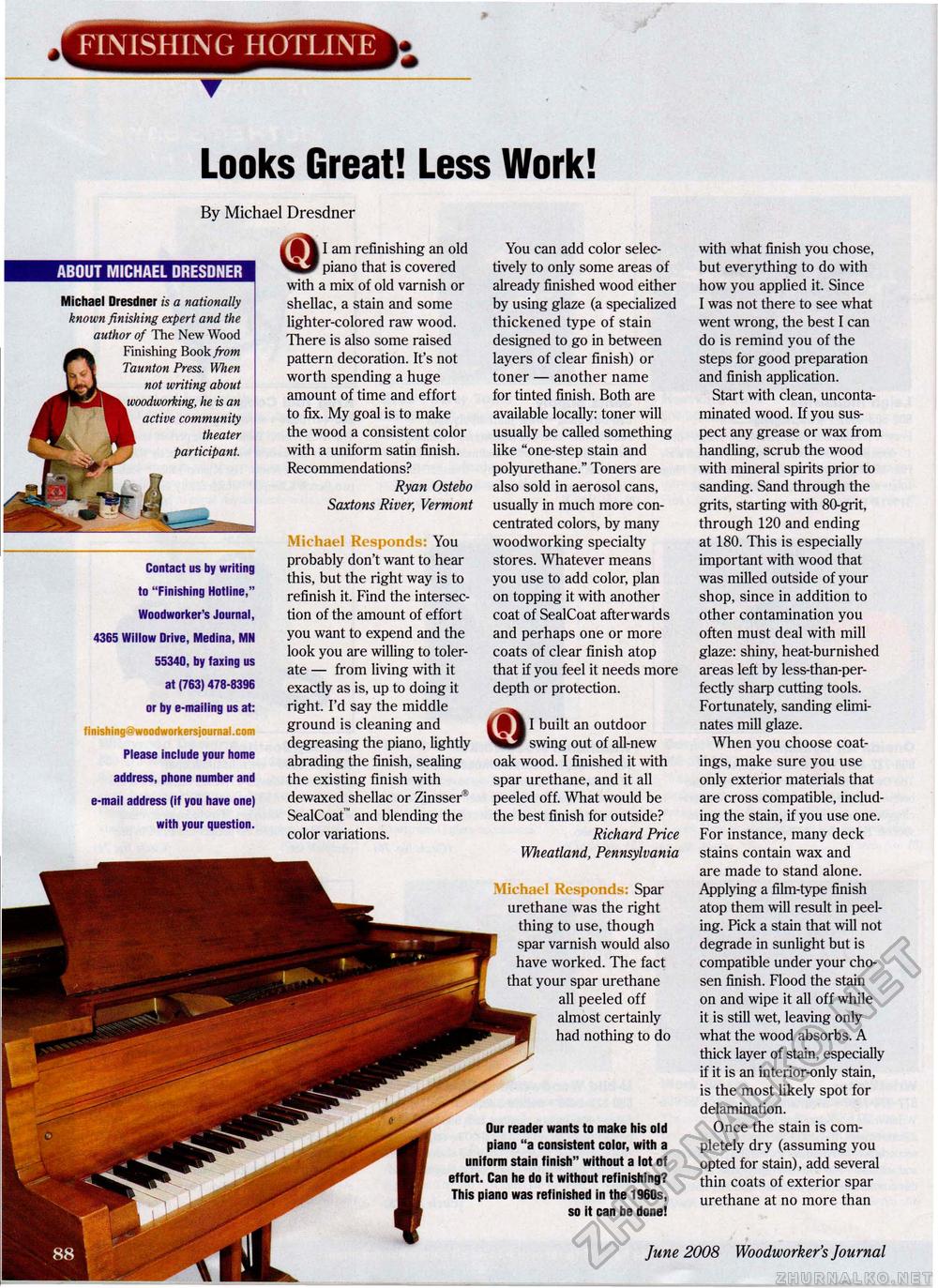Woodworker's Journal 2008-32-3, страница 88
FINISHING HOTLINE 2 Looks Great! Less Work! By Michael Dresdner ABOUT MICHAEL DRESDNER Contact us by writing to "Finishing Hotline," Woodworker's Journal, 4365 Willow Drive, Medina, MN 55340, by faxing us at (763) 478-8396 or by e-mailing us at: finishing@woodworkersjournal.com Please include your home address, phone number and e-mail address (if you have one) with your question. 11 am refinishing an old ' piano that is covered with a mix of old varnish or shellac, a stain and some lighter-colored raw wood. There is also some raised pattern decoration. It's not worth spending a huge amount of time and effort to fix. My goal is to make the wood a consistent color with a uniform satin finish. Recommendations? Ryan Ostebo Saxtons River, Vermont Michael Responds: You probably don't want to hear this, but the right way is to refinish it. Find the intersection of the amount of effort you want to expend and the look you are willing to tolerate — from living with it exactly as is, up to doing it right. I'd say the middle ground is cleaning and degreasing the piano, lightly abrading the finish, sealing the existing finish with dewaxed shellac or Zinsser® SealCoat" and blending the color variations. Michael Dresdner is a nationally known finishing expert and the author of The New Wood Finishing Book from Taunton Press. When not writing about he is an active community theater participant. with what finish you chose, but everything to do with how you applied it. Since I was not there to see what went wrong, the best I can do is remind you of the steps for good preparation and finish application. Start with clean, unconta-minated wood. If you suspect any grease or wax from handling, scrub the wood with mineral spirits prior to sanding. Sand through the grits, starting with 80-grit, through 120 and ending at 180. This is especially important with wood that was milled outside of your shop, since in addition to other contamination you often must deal with mill glaze: shiny, heat-burnished areas left by less-than-per-fectly sharp cutting tools. Fortunately, sanding eliminates mill glaze. When you choose coatings, make sure you use only exterior materials that are cross compatible, including the stain, if you use one. For instance, many deck stains contain wax and are made to stand alone. Applying a film-type finish atop them will result in peeling. Pick a stain that will not degrade in sunlight but is compatible under your chosen finish. Flood the stain on and wipe it all off while it is still wet, leaving only what the wood absorbs. A thick layer of stain, especially if it is an interior-only stain, is the most likely spot for delamination. Once the stain is completely dry (assuming you opted for stain), add several thin coats of exterior spar urethane at no more than Our reader wants to make his old piano "a consistent color, with a uniform stain finish" without a lot of effort. Can he do it without refinishing? This piano was refinished in the 1960s, so it can be done! 88 June You can add color selectively to only some areas of already finished wood either by using glaze (a specialized thickened type of stain designed to go in between layers of clear finish) or toner — another name for tinted finish. Both are available locally: toner will usually be called something like "one-step stain and polyurethane." Toners are also sold in aerosol cans, usually in much more concentrated colors, by many woodworking specialty stores. Whatever means you use to add color, plan on topping it with another coat of SealCoat afterwards and perhaps one or more coats of clear finish atop that if you feel it needs more depth or protection. 11 built an outdoor swing out of all-new oak wood. I finished it with spar urethane, and it all peeled off. What would be the best finish for outside? Richard Price Wheatland, Pennsylvania Michael Responds: Spar urethane was the right thing to use, though spar varnish would also have worked. The fact that your spar urethane all peeled off almost certainly had nothing to do 2008 Woodworker's Journal |








